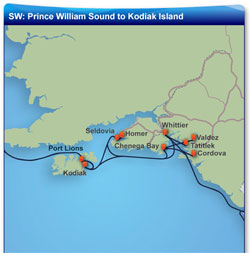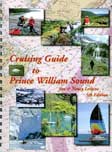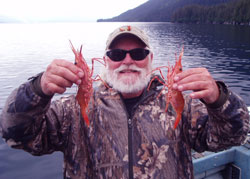
The North Gulf Coast
Sometimes referred to as Alaska's "Lost Coast", the North Gulf Coast provides the eastern and northern border of Prince William Sound. With the exception of Valdez, this area is very remote and accessible only by private boat or single-engine aircraft. It offers outstanding freshwater and saltwater fishing opportunities, in remote settings. The Marine fishery is most easily accessed out of Valdez or Whittier. For anglers based out of Fairbanks who have a hankering for saltwater fishing, Valdez is the destination of choice, at about 350 miles. The drive takes just over 6.5 hours from Fairbanks, making a Valdez trip a substantial commitment. Still, fishing out of Valdez can be outstanding at times. For the outdoor photographer interested in photographing pre-spawning salmon, check out the pink salmon run, with 10-15 million fish crowding Valdez Arm, and accessible in many locations from shore on the road system. If your timing is good, you will witness fish so densely-packed that there seems to be barely enough water to handle the load.
Public-Use Cabins
The North Gulf Coast and Prince William Sound contain dozens of cabins that are available for use by the general public. These cabins are controlled by either the state or federal government, and most require advance reservations, and user fees are usually charged by the night. Amenities are spartan; expect to find an outhouse, bunks with no bedding or mattresses, no food, no dishes or cookstove, and no power or running water. Some include the use of a boat, but you will probably have to bring an outboard if one is needed. Most have wood-fired or oil-fired stoves for heat. See our Public-Use Cabins page for locations, recommended gear, reservation, and contact information.
Cordova Area
Several cabins are available in the Cordova area, few of which are available from the road system.
- McKinley Trail Cabin. 12'X14', sleeps 6, wood stove (bring your own or cut your own wood). Located on the road system on the Copper River Highway, about 20 miles out of Cordova. CLICK HERE for availability, rates and reservations.
- McKinley Lake Cabin. 16'X20', sleeps 6, wood stove (bring or cut your own firewood), rainwater catchment barrel. Located on McKinley Lake, 2.25 miles from the McKinley trailhead. CLICK HERE for availability, rates, and reservations.
- Power Creek Cabin. 12'X20', sleeps 8, wood stove, rainwater catchment barrel. Bring or cut your own firewood. Accessed via a 4.2-mile hike on Power Creek Trail near Cordova. CLICK HERE for availability, rates, and reservations.
- Tideman Slough Cabin. 12'X14', sleeps 6, oil stove, rainwater catchment barrel. Bring your own heating oil. Located on the east bank of Tideman Slough, and is accessible only by boat from the Alaganik boat ramp. Must be accessed at high tide. CLICK HERE for availability, rates, and reservations.
Hinchinbrook Island
Three cabins are located on Hinchinbrook Island, all of which are popular with hunters.
- Double Bay Cabin. 12'X14', sleeps 6, oil stove (bring your own fuel), wood stove (bring or cut your own firewood), rainwater catchment barrel. Located on the east side of Double Bay (north shore of Hinchinbrook Island). Access via floatplane or powerboat out of Cordova at high tide. CLICK HERE for availability, rates, and reservations.
- Hook Point Cabin. 16'X16', sleeps 6, oil stove (bring your own fuel), wood stove (bring or cut your own firewood), rainwater catchment barrel. Located 25 air miles southwest of Cordova, 1.5 miles west of Hook Point along the south side of Hinchinbrook Island. Can be accessed via wheel plane at low tide. CLICK HERE for availability, rates, and reservations.
- Shelter Bay Cabin. 12'X20', sleeps 6, oil stove (bring your own fuel), wood stove (bring or cut your own firewood), rainwater catchment barrel. Located on the southwest shore of Shelter Bay (north shore of Hinchinbrook Island). Access via floatplane or boat at high tide, or via wheelplane at low tide. CLICK HERE for availability, rates, and reservations.
Valdez Area
- Jack Bay Cabin. 12'X14', sleeps 6, oil stove (bring your own fuel), rainwater catchment barrel. Located at the east end of Jack Bay (via Valdez Narrows). Access at high tide via floatplane or boat out of Valdez. CLICK HERE for availability, rates, and reservations.
Decision Point State Marine Park (Whittier area)
These facilities are located about eight miles east of Whittier, on the south side of Passage Canal. These cabins are accessible by private boat, water taxi out of Whittier, floatplane, or kayak. There is no sheltering anchorage, and these cabins are popular with kayakers. The Decision Point State Marine Park cabins are administered by the Alaska Department of Natural Resources (DNR). Be sure to read their Fact Sheet on these cabins.
- Decision Point Cabin. 16'X16', sleeps 8, oil stove provided (uses No. 1 fuel oil or Kerosene only). No freshwater source, so you need to haul your own water. Located along the west side of Squirrel Cove. CLICK HERE for availability, rates, and reservations.
- Tent Platforms. Four tent platforms are accessible via a boardwalk from the Decision Point Cabin. Each platform can accommodate one tent. A cooking area and a bear-proof food locker are provided. CLICK HERE for availability, rates, and reservations.
Shoup Bay State Marine Park (Valdez area)
Shoup Bay Marine Park is located 8.5 miles north of Valdez and is accessible by boat, water taxi out of Valdez, floatplane, or by hiking an 11-mile trail from Valdez. Several cabins are located there. The Shoup Bay State Marine Park cabins are administered by the Alaska Department of Natural Resources (DNR). Be sure to read their Fact Sheet on these cabins.
- McAllister Creek Cabin. 16'X16', sleeps 8, located on the west side of the outer bay, at the outflow of McAllister Creek. CLICK HERE for availability, rates and reservations.
- Kittiwake Cabin. 16'X16', sleeps 8, located along the inner lagoon. Wheelchair accessible. CLICK HERE for availability, rates, and reservations.
- Moraine Cabin. 16'X16', sleeps 8, located on the east side of the inner lagoon. CLICK HERE for availability, rates and reservations.
Cruising the Sound
Several cruises are available in Southcentral Alaska, some originating out of the Inside Passage in Southeast (see Region 1 for details), and others between towns on the Kenai Peninsula. The larger ships, however, visit Cordova, Valdez, Whittier, Seward, and on some occasions Homer. Anchorage-bound cruise passengers typically debark in Whittier and are taken from there to Anchorage via bus or the Alaska Railroad, which has a spur that terminates in Whittier. Shorter day-cruises are available (also known as "Marine Tours", departing and returning from Cordova, Valdez, Whittier, Seward, and Homer. The agenda aboard these short cruises is typically wildlife viewing, whale watching, and glacier viewing.
The Alaska Marine Highway System
The State of Alaska operates a ferry system throughout Region 2, with stops in Cordova, Tatitlek, Valdez, Whittier, Chenega Bay, Seldovia, Homer, Kodiak, and Port Lions, before continuing on to the Alaska Peninsula. Vehicles are allowed on the ferry. Amenities include staterooms (must be reserved well in advance), bathrooms with showers, hot and cold meals and drinks for purchase, alcoholic beverages, and much more. For travelers on a budget, sleeper recliners are available, tents can be set up in certain areas aboard ship, or you can simply roll out your sleeping bag for a night under the stars. You can even bring a cooler along with your own food if you prefer. The schedule varies somewhat from winter (October through April) and summer (May through September). Visit the Alaska Marine Highway website for schedule and pricing information. Or visit their YouTube site for video snapshots of the ships, the amenities, and to discover this unique transportation system for yourself.
| Route Segment | Running Time | Naut. Miles | Stat. Miles |  |
|
| Valdez-Cordova | 5.5 hours | 74 | 84 | ||
| Cordova-Whittier | 6.25 hours | 97 | 110 | ||
| Whittier-Valdez | 6.75 hours | 78 | 89 | ||
| Kodiak-Port Lions | 2.5 hours | 48 | 55 | ||
| Port Lions-Homer | 10 hours | 134 | 152 | ||
| Homer-Seldovia | 1.5 hours | 17 | 19 | ||
| Homer-Kodiak | 9.5 hours | 136 | 155 | ||
Boating Opportunities
The North Gulf Coast and Prince William Sound offer excellent opportunities for both freshwater and saltwater boaters. The port towns of Cordova and Valdez offer launch facilities, fuel, shore-based lodging, dry boat storage, and permanent or transient berths, fish cleaning stations, and many other amenities of interest to power boaters or sailors. They also offer excellent charter fishing opportunities, the most accessible of which is Valdez, which is on the road system (anglers interested in Cordova must fly into town before embarking on an excursion). All of these locations are within striking distance of outstanding fishing for salmon, halibut, rockfish, and lingcod, and all of them provide excellent access to prime public hunting areas.
Boat Launch Facilities
Whether you're looking at freshwater or saltwater, you need to know where the launch ramps are. Check out our Region 2 Boat Launches page for locations and instructions.
Prince William Sound
The sound is the crown jewel of southcentral Alaska. Home to vast ice fields, deep, glacier-carved fjords, spectacular forested mountains with trails that wind up to beautiful lookouts, and an ecosystem that is teeming with fish and wildlife all combine to make Prince William Sound a premier destination for anyone interested in the Alaska outdoors. The Good Friday Earthquake, which took place in March 1964, lifted some areas several feet, and the evidence of this is still visible today. A resulting tsunami inundated much of the town of Valdez; much of the town has been relocated farther inland as a result.
On March 24, 1989, the Exxon Valdez oil tanker ran aground on Bligh Reef, spilling between 260,000 to 750,000 barrels of crude oil, which eventually impacted 1,300 miles of the Sound’s 3,000 miles of coastline. Today there is little visible evidence that the spill ever occurred. Long-term effects are still to be determined. Several tour companies operate day-cruises out of Cordova, Valdez, Whittier, and Seward. These harbors are also the origin points for charter fishing operations, and private boaters use these areas to launch out on fishing, hunting, and sightseeing adventures across the Sound. If you plan to visit Prince William Sound, you would do well to purchase a copy of “The Cruising Guide to Prince William Sound”, by Jim and Nancy Lethcoe. It is an invaluable guide to all the safe anchorages, hazards, weather patterns, hiking trails, and other points of interest for outdoor recreation throughout the Sound.
If you plan to visit Prince William Sound, you would do well to purchase a copy of “The Cruising Guide to Prince William Sound”, by Jim and Nancy Lethcoe. It is an invaluable guide to all the safe anchorages, hazards, weather patterns, hiking trails, and other points of interest for outdoor recreation throughout the Sound.
FAA Web Cams Around Prince William Sound
Cordova | Johnstone Point | Middleton Island | Potato Point | Seward | Valdez | Whittier
Several tour companies operate day-cruises out of Cordova, Valdez, Whittier, and Seward. These harbors are also the origin points for charter fishing operations, and private boaters use these areas to launch out on fishing, hunting, and sightseeing adventures across the Sound.
Freshwater Fishing in the North Gulf Coast and Prince William Sound
Freshwater fishing opportunities abound across Region 2. All five species of Pacific salmon swim its rivers, and grayling, lake trout, Dolly Varden, and rainbow trout can be found in lakes and rivers throughout the area. There are many remote fly-out opportunities in this area, and saltwater fishing is outstanding for a variety of species.
Rivers
This area contains a number of rivers of interest to anglers, but most of the river systems are short and difficult to access. One of the most popular is the Tsiu (pronounced "sai-you"), but it requires Bush aircraft access to the beach in the tidewater area. The Situk River (pronounced "see-tuck") offers legendary fishing for spring steelhead, which can be done by floating or from shore.
CAUTION: Before embarking on a river trip anywhere in Alaska, do your homework! Double-check your information against details from your air charter, get flow information from the Alaska-Pacific River Forecast Center (APRFC), and other floaters. Check our Boating Forums for discussions with people who have been there. If you are not familiar with the characteristics of Alaska's rivers, read our River Information page for a general orientation, and a list of resources to get you started on the learning process.
Saltwater Fishing in Prince William Sound
It is worth noting that Prince William Sound and its connecting bays offer seasonal fishing opportunities for salmon sharks. This is a closely-regulated fishery, however, for those looking for something truly unique in the way of big-game fishing, several charter outfits offer salmon shark trips. This cousin of the great white shark is an aggressive jumper that takes a variety of large baits. Special rigging is required, and catch-and-release fishing is encouraged. Check out the article by Crackerjack Charter's captain Andy Meziro, "The Shark- Alaska's Toughest Fish" for an exciting read on salmon shark fishing in Alaska.
Check the ADF&G website for details on the following available saltwater species, which are available in this area.
Atka Mackerel | Black Cod | Chum Salmon | Cutthroat Trout | Dolly Varden | Halibut | King Salmon | Lingcod | Pink Salmon | Pollock | Red Salmon | Salmon Shark | Silver Salmon | Steelhead | Yelloweye Rockfish
Shrimping

Steve Kalek with a pair of PWS spot shrimp
Prince William Sound contains a healthy population of spot shrimp, with both a commercial and a sport fishery targeting this species. The meat is sweeter than most shrimp, and they are highly prized on the dinner table. Shrimping is done with pots that are baited and dropped into waters in excess of 300' deep and left to "soak" for several hours. This pot fishing technique is considered the most environmentally friendly method of shrimping, with virtually no seafloor damage and almost no bycatch of other species. Recreational shrimpers typically go out for a weekend and may drop six or eight pots in an area, then go fishing for a while and pull their pots at the end of the weekend. Mark the buoys on your pots with your name and address, ensure they have plenty of line on them to accommodate the rising tide and currents, and take a GPS reading on their location. The amount of line you need greatly depends on the water depth; plan on twice as much line as the anticipated depth. Because of the great depths involved, most shrimpers use a "pot puller"; a hydraulic winch mounted to the boat, to pull the pots up from the seafloor. Keep track of your pots! If you didn't put enough line out, the rising tide or changing currents can lift your pots and cause them to drift off into deeper water. Fishermen can be cited for unrecovered pots that are left out after the season closes. Pot theft remains a problem in accessible areas of the Sound, so check your pots more often, or position them where you can easily spot other boats in the vicinity. Visit our Saltwater Fishing Forum for more information on shrimping locations, how-tos, and other details that will make your efforts more productive.
Check the ADF&G website for information on the following shellfish found in Prince William Sound.
Coonstripe Shrimp | Northern Shrimp | Sidestriped Shrimp | Spot Shrimp | Golden King Crab | Red King Crab | Tanner Crab
Regional Details
For details on specific fishing areas in Region 2, including amenities and equipment/service providers in these locations, please visit our pages on the following areas:
Anchorage | Cordova | Homer | Kenai / Soldotna | Kodiak | Northern Cook Inlet | Prince William Sound | Seward | Valdez | Whittier
Hunting Opportunities
The state of Alaska is divided into 26 Game Management Units (GMU), some of which are divided further into sub-units. Each of these units or sub-units may contain different species, different seasons, and different legal requirements for hunting. GMUs are aggregated into regional groupings, and each of these regions operates under the oversight of a team of ADFG employees, including area biologists who are responsible for game management in their assigned portions of the region. There are five regions in the state of Alaska. Outdoors Directory uses these regions to divide the state into smaller pieces, for the sake of organization. When you plan your Alaska hunt, you need to know both the GMU in which you will be hunting and the region. In this way, you can ensure you are following the correct regulations for the area, and you know which regional biologist to contact for details about that area.
Region 2 contains GMUs 6, 7, 8, 14(C) and 15, and covers 25,645 square miles (an area slightly larger than the state of West Virginia). The ADF&G Region 2 office is located in Anchorage.
Species Information
Want to learn more about the critters that inhabit the North Gulf Coast and Prince William Sound? Visit our species pages, where you'll find detailed instructions on the biology, distribution, and how to hunt the big-game species that inhabit this area. Here are direct links to our pages on the species found in this area:
Black Bear | Brown Bear | Goat | Moose | Sitka black-tailed deer | Wolf
ADF&G Region 2 Information
ADF&G Management and Harvest Reports, a vital hunt-planning tool, can be found AT THIS LINK. Reports are listed in sequential order by species. For detailed research into population trends, review several reports. For more recent data contact the area biologist. The Region 2 biologists are located in Anchorage. The phone number there is 1 (907) 267-2257.

